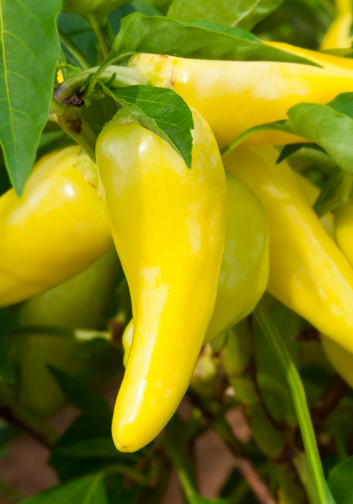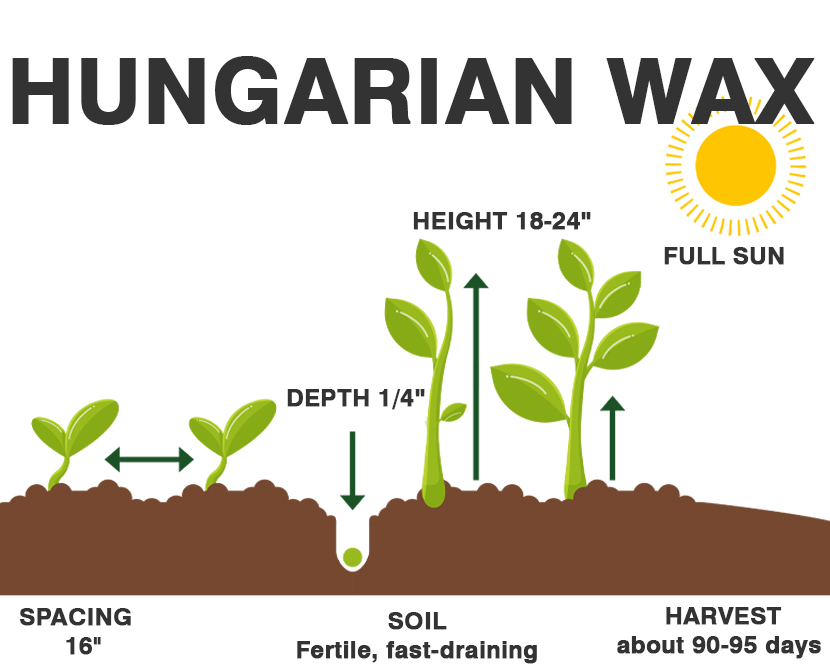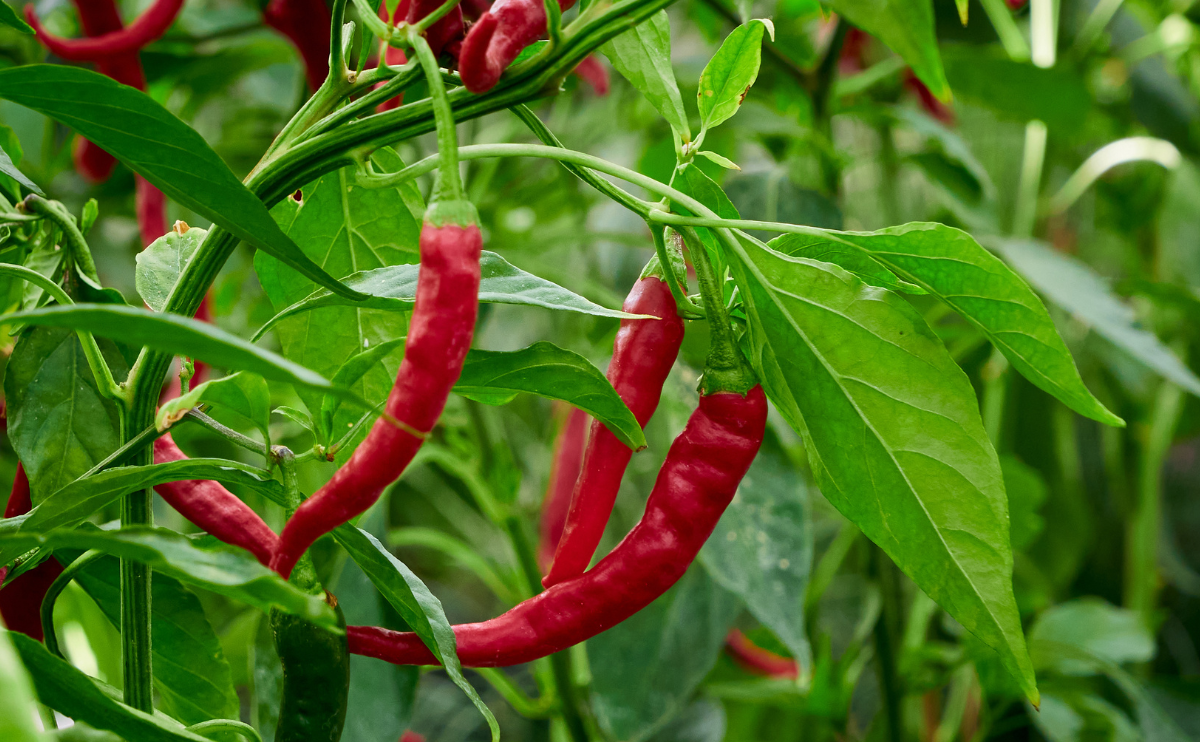The Hungarian Wax Pepper, as its name suggests, originated in Hungary. Also known as the Hungarian Hot Wax Pepper, it is easily confused with the similar-looking banana pepper, but it is much hotter.
The Hungarian Wax is harvested before complete maturity, while it is still yellow, and about 8 inches long and 2 inches thick. If left to mature fully, these peppers could grow larger and would turn red, and their heat level would increase considerably.

| Common Name | Hungarian wax pepper |
| Botanical Name | Capsicum annuum var. annuum ‘Hungarian wax’ |
| Family | Solanaceae |
| Plant Type | Perennial, vegetable |
| Size | 1–4 ft. tall, 1–2 ft. wide |
| Sun Exposure | Full sun |
| Soil Type | Moist, well-drained |
| Soil pH | Acidic, neutral |
| Bloom Time | Summer |
| Hardiness Zones | 9–11 (USDA) |

When to Plant?
This will be determined by your planting zone. There is a final frost date for each area. As a result, you can plan your gardening activities around this date. Check our Frost Dates Across North America: First & Last Frost Dates Chart. However, the date will not be the same for every plant.
How to Plant
Only home gardeners who enjoy long growing seasons in the Deep South should attempt to sow pepper seeds directly in the vegetable garden. Most of us must start our own pepper plants indoors about 8-10 weeks before transplanting, which should be done 2-3 weeks after the expected last frost.

As soon as seedlings emerge, provide plenty of light on a sunny windowsill or grow seedlings 3-4 inches beneath fluorescent plant lights turned on 16 hours per day, off for 8 hours at night. Raise the lights as the plants grow taller. Incandescent bulbs will not work for this process because they will get too hot. Most plants require a dark period to grow, do not leave lights on for 24 hours.
Seedlings do not need much fertilizer, feed when they are 3-4 weeks old using a starter solution (half strength of a complete indoor houseplant food) according to manufacturer’s directions.
If you are growing in small cells, you may need to transplant the seedlings to 3 or 4-inch pots when seedlings have at least 3 pairs of leaves before transplanting to the garden, so they have enough room to develop strong roots.
Before planting in the garden, seedling plants need to be “hardened off”. Accustom young plants to outdoor conditions by moving them to a sheltered place outside for a week. Be sure to protect them from wind and hot sun at first. If frost threatens at night, cover or brings containers indoors, then take them out again in the morning. This hardening off process toughens the plant’s cell structure and reduces transplant shock and scalding
How to Cultivate
Keep weeds under control during the growing season. Weeds compete with plants for water, space, and nutrients, so control them by either cultivating often or using a mulch to prevent their seeds from germinating.
Mulches also help retain soil moisture and maintain even soil temperatures. This is especially important for peppers, as their roots may be easily damaged when weeding, and this can lead to blossom end rot.
Keep plants well-watered during the growing season, especially during dry spells. Plants need about 1-2″ of rain per week during the growing season. Use a rain gauge to check to see if you need to add water. It’s best to water with a drip or trickle system that delivers water at low pressure at the soil level. If you water with overhead sprinklers, water early in the day so the foliage has time to dry off before evening, to minimize disease problems. Keep the soil moist but not saturated.
Note that hot peppers tend to be hotter when they have less water and fertilizer. If they receive plenty of water and fertilizer, they may be milder than expected. Monitor for pests and diseases. Check with your local Cooperative Extension Service for pest controls recommended for your area.
Try planting pepper plants near tomatoes, parsley, basil, and carrots in your home vegetable garden. Don’t plant them near fennel or kohlrabi. Peppers are very colorful when in full fruit and combine well with green herbs, okra, beans, and cucumber fences in the garden bed.
How to Harvest
Peppers will turn green when starting to approach maturity. They can be harvested at this point, or allowed to ripen on the plant. If collected early, plants will continue to flower and fruit more frequently, though this early collection might result in differences in flavor if used fresh.
Use scissors or snip to cut branches and harvest peppers. Do not remove by hand as plants can be easily damaged.
Hydroponics
Germination:To germinate Hungarian Hot Wax pepper seeds hydroponically, fill a small container with soilless potting mix or a hydroponic starter plug and place one or two seeds in it. Keep the container in a warm, well-lit area with a temperature between 75-85°F (24-29°C) and cover it with plastic wrap or a dome to maintain humidity. Germination should occur within 7-10 days.
pH range: The pH range for hydroponic Hungarian Hot Wax peppers should be between 5.5 and 6.5. Maintain the pH level by using a pH meter or pH strips and adjusting it using pH up or pH down solutions.
EC: The ideal electrical conductivity (EC) range for Hungarian Hot Wax peppers is between 2.0 and 3.0 mS/cm. This level provides enough nutrients for the plant to grow healthily.
PPM: The parts per million (PPM) range for Hungarian Hot Wax peppers is between 1000 and 1500 ppm.
Humidity: Maintain a humidity level between 60% and 70% for hydroponic Hungarian Hot Wax peppers. You can use a humidifier to maintain the desired humidity level.
Light hours: Provide Hungarian Hot Wax peppers with 14-16 hours of light per day during the vegetative stage and 12 hours of light per day during the flowering stage. Use high-intensity grow lights, such as LEDs or HID lamps.
Temperature air: Maintain a temperature between 70-85°F (21-29°C) during the day and 60-70°F (16-21°C) during the night for hydroponic Hungarian Hot Wax peppers.
Temperature water: Maintain the water temperature between 65-75°F (18-24°C) for hydroponic Hungarian Hot Wax peppers. Use a water heater or chiller to maintain the desired temperature range.
With these guidelines, you should be able to grow healthy plants hydroponically. Good luck, and happy growing!



